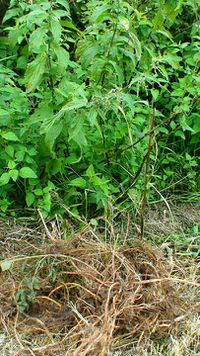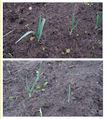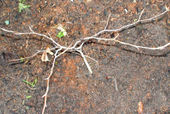Soil management
This page is to prepare and collect information for one or more chapters in the course. --John Eagles 01:13, 23 December 2011 (PST)
Chunks of information
- The use of the stinging nettle for soil improvement: The photo shows the larger species of the stinging nettle (Urtica dioica) with roots that were dug out. This plant can have good use for improving the soil. The long roots bring many minerals from lower down to the upper soil. The plant can grow up to 2 meters high and produces a lot of material for mulch or compost, so it is an excellent green fertilizer.
The roots also make the soil very loose and crumbly.
- The following is a quote from http://en.wikipedia.org/wiki/Stinging_nettle:
"The growth of stinging nettle is an indicator that an area has high fertility (especially phosphorus) and has been disturbed.
- Nettles contain a lot of nitrogen and so are used as a compost activator or can be used to make a liquid fertiliser which although somewhat low in phosphate is useful in supplying magnesium, sulphur and iron. They are also one of the few plants that can tolerate, and flourish in, soils rich in poultry droppings."
- You can use the nettles for most excellent fertilizer. Put the plants in a ton of water and let it stand for a few weeks. This fertilizer is rich of nitrogen and also of minerals such as magnesium, sulphur and iron. This fertilizer can be applied by pouring it next to vegetables or flowers. It is taken in by the plants very fast.

Grelinette (garden fork)
- The grelinette is a very useful tool in organic farming. It doesn't disturb the layers of the soil and it's much easier than a spade to prepare a soil for planting or sowing.
- Disturbing the soil layers: Top soil: micro-organisms that need oxygen. Lower: micro-organisms that need oxygen and bacteria that can do without. Still lower down: micro-organisms that don't like oxygen.
In addition to this, bugs and small animals that live in the soil. For organic farming we need these micro-organisms. They make fertilizers and live in symbiosis with the roots of plants. Plants have their typical micro-organisms around them that feed their roots and protect them against disease. The best is to keep the soil covered with green like in grassland, or with a layer of mulch, like in a forest. I'll write about this more later. Once a soil is treated well it becomes a bit like a sponge and doesn't need much treatment. In ancient times many peoples didn't use plows that turned the soil upside down, they used a kind of cultivator-plow, a pin pulled through the ground. It didn't disturb the soil layers.
Gallery
Soils want to be covered in some way. In nature, either mulch in the form of fallen leaves and branches cover a soil, or all kinds of plants grow there. In a garden, weeds grow where you don't remove them. These weeds can rival with your crops, but in times that no vegetables are growing there, weeds have a useful function.
See also
External links
- Grelinette Wikipedia
- Garden fork Wikipedia




